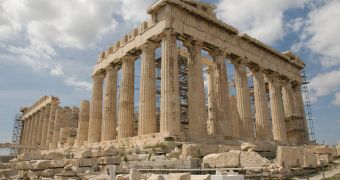New evidence brought forth in studies seems to indicate the fact that the bright and shiny-white marbles on the triangular gables of the Athenian Parthenon were in the past brightly colored, and that the paintings most likely covered the entire surface of the temple. A team of experts from the British Museum in London are responsible for the find, having used a non-invasive imaging technique on the ancient sculptures, which revealed clear marks of the famous pigment named Egyptian blue.
This puts an end to the squabbles that existed in the archaeological community, where some said that the statues had been bright-white ever since they were first installed in the remarkable structure, while others argued that they must have been painted in bright colors, as were all statues in Antiquity. According to the British research team, the pigment that was identified on the marbles was widely used before 800 AD, when it fell out of grace on account of the fact that other, more efficient types of paint emerged.
The British researchers used a very innovative technique to find the paint traces. They knew that Egyptian blue emitted near-infrared radiation when excited by visible light, so they devised a machine that could identify this radiation, Nature News reports. By shinning red LED light on the white surfaces, and then analyzing its reflection with an infrared camera, they were finally able to pick up the signs of paint that had eluded other researchers for centuries.
The find comes at a very shaky time. The marbles on which the study was conducted are known as the Elgin marbles, because the British Lord Elgin removed them from the Parthenon, between 1799 and 1803, and brought them back to England, where they were displayed in the British Museum. He basically stole the artifacts. Now, with the Acropolis Museum in Athens scheduled to be opened on June 20th, British authorities including the Queen, the Prime Minister, and the director of the British Museum all declined their invitations to attend.
They also said that they would not grant Greece's request of returning the stolen goods and added that they would only give them to the Athens museum on a short-term, borrowing-type of contract, and then only if the Southern European nation acknowledged the “rightful” ownership that England allegedly had over the goods.

 14 DAY TRIAL //
14 DAY TRIAL //